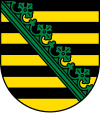Diamond wreath (heraldry)


The diamond wreath is a style element in heraldry that is placed in coats of arms over the heraldic images and common figures and thus represents a special feature. It is a decorative strip that is set with green leaves and is similar to the crown segment. Heraldists consider the diamond wreath to be a common figure. It is placed diagonally over the coat of arms. Whether it is curved or straight is not important. If it is emblazoned (described) in a curved manner, it should also be represented that way. The straight execution would not diminish the coat of arms. The origin is not clearly established. A coincidental leaf decoration is assumed to be the beginning, although a connection with the rhombus plant, which was previously regarded as a disaster-resistant plant, cannot be excluded. Heraldists assume the Schapel or the Sendelbinde , this medieval headdress for women consisted of a cross of flowers. It was a gift from women to knights. They put the wreath on their helmets.
Much has been written in literature about the diamond wreath. It can be found in the coat of arms of the Duchy of Saxony from 1262 and later also in those of the Wettins . There is also a diamond wreath in the coat of arms of the Dukes of Savoy , in the coat of arms of the Princes of Liechtenstein and in the coat of arms of the Thuringian family von Wegeleben. The beginning was also set to around 1473, since the diamond wreath is shown as a real crown ring on a coat of arms in the Vienna State Library.
difference
When looking at the bar shields (Saxony and Saxony-Anhalt), the different color beginnings are noticeable, although both have put on the Saxon diamond wreath. They can be recognized as the "Saxony coat of arms". The shield beginning with gold is the actual coat of arms from Ballenstedt before 1212 without a diamond wreath (belonging to the Anhalt family). It was included in the coat of arms of the Duchy of Saxony . In 1817 the bar division began with black at the top. To better distinguish the coat of arms from that of the Kingdom of Saxony , it was determined in 1864 that gold should be used. The shield division is: divided nine times or divided ten times . The diamond wreath on Anhalt coats of arms should be curved, on other coats of arms straight. In modern heraldry, it is no longer important.
Quote
"The so-called diamond wreath in the Saxon coat of arms is a crown circlet placed diagonally, emerged from an ornamental or rather stylistically treated leaf wreath (diamond wreath)."
See also
- List of coats of arms with diamond wreath
- Coat of arms of Saxony-Anhalt
- State coat of arms of Saxony
literature
- Friedrich-Karl zu Hohenlohe-Waldenburg: The Saxon diamond wreath. Heraldic monograph. Weise, Stuttgart 1863, digitized .
- Gert Oswald : Lexicon of Heraldry. Bibliographical Institute, Mannheim / Vienna / Zurich / Leipzig 1984, ISBN 3-411-02149-7 ; 2nd unchanged edition with the subtitle Von Apfelkreuz bis Zwillingsbalken, Battenberg, Regenstauf 2006, ISBN 3-86646-010-4 ; 3rd edition 2011, ISBN 978-3-86646-077-5 .
Individual evidence
- ↑ Christina Becela-Deller: Ruta graveolens L. A medicinal plant in terms of art and cultural history. (Mathematical and natural scientific dissertation Würzburg 1994) Königshausen & Neumann, Würzburg 1998 (= Würzburg medical-historical research. Volume 65). ISBN 3-8260-1667-X , p. 210.
- ↑ Oswald (1984).
- ↑ Eduard Freiherr von Sacken : Catechism of Heraldry. Fundamentals of heraldry (= Weber's illustrated catechisms . Volume 51 ). Publishing bookstore by JJ Weber, Leipzig 1862, The common figures , p. 73 .
